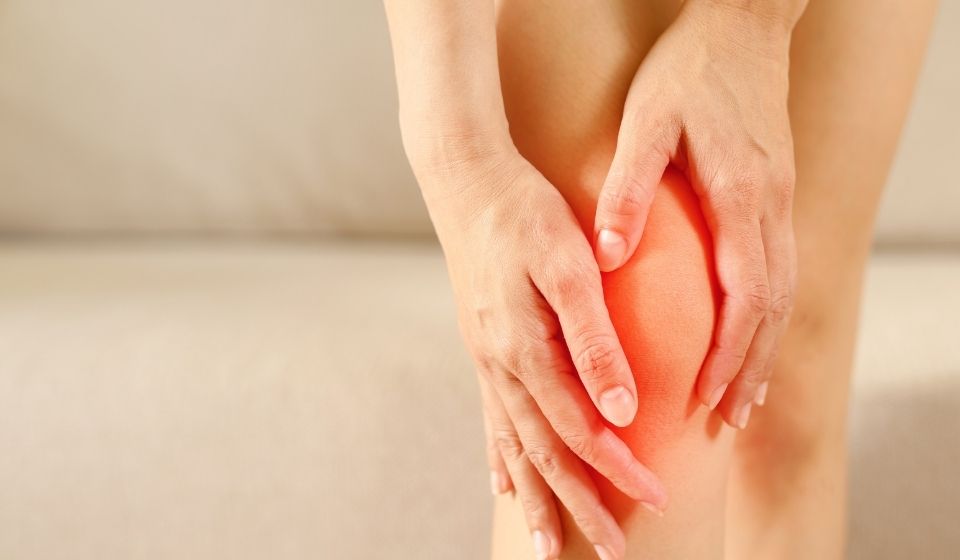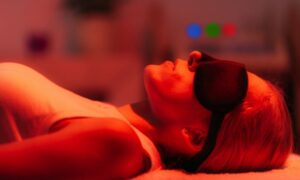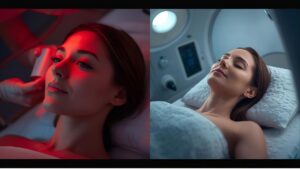Key Takeaways
- Low-level laser therapy for lymphedema is an evidence-based, FDA-cleared, and safe treatment.
- Laser therapy for lymphedema improves lymphatic drainage, reduces swelling, and softens fibrosis.
- Laser treatment for lymphedema works best when combined with compression, exercise, and manual drainage.
- Red light therapy for lymphedema is helpful in mild cases, but LLLT offers deeper, longer-lasting benefits.
Lymphedema is a challenging condition that affects millions of people worldwide, often leading to swelling, discomfort, and reduced mobility. Traditional treatments like compression garments, exercise, and manual lymphatic drainage can help manage symptoms but often fall short in addressing the root cause. Fortunately, recent advancements in low-level laser therapy (LLLT), also called red light therapy or photobiomodulation, offer promising results for those struggling with this condition.
In this blog, we’ll explore how laser therapy works, the science behind it, clinical evidence, treatment protocols, and safety considerations to help you understand whether it could be an option for you.
What Is Lymphedema?

Lymphedema is a chronic and progressive disorder in which lymphatic fluid accumulates in the body’s tissues, commonly affecting the arms, legs, or other areas. This build-up of fluid can cause noticeable swelling, heaviness, discomfort, and even pain. Lymphedema often occurs as a result of:
- Surgical procedures that remove or damage lymph nodes (commonly after breast cancer surgery)
- Radiation therapy that affects the lymphatic pathways
- Trauma or infections that impair lymphatic flow
The condition can severely impact quality of life, limiting mobility and making everyday activities more challenging. While symptom management is crucial, targeting the underlying lymphatic dysfunction can offer more meaningful relief. This is where low-level laser therapy comes in.
What Is Low-Level Laser Therapy for Lymphedema?
Low-level laser therapy (LLLT), also known as photobiomodulation (PBM), is a non-invasive treatment that uses specific wavelengths of low-intensity laser light to stimulate healing, reduce swelling, and improve lymphatic flow.
Unlike surgical lasers, which cut or burn tissue, LLLT uses gentle light energy that activates cellular repair without causing damage.
Key Characteristics of LLLT
| Parameter | Details |
| Wavelengths | 650 nm – 1000 nm |
| Light Types | Red light & near-infrared light |
| Power Output | 5 mW – 500 mW |
| Treatment Devices | LED panels, handheld lasers, and clinical laser clusters |
| Therapy Type | Non-invasive, painless, drug-free |
Fact: The U.S. FDA approved laser treatment for lymphedema in 2006, making it a trusted and clinically accepted therapy worldwide.
How Laser Therapy for Lymphedema Works
Laser therapy for lymphedema works at both the cellular and vascular levels to restore lymphatic function and reduce chronic swelling.
- Stimulates Lymphangiogenesis (New Lymph Vessel Formation)
Laser therapy activates vascular endothelial growth factors (VEGF), which promote the development of new lymphatic vessels. This process helps improve long-term fluid clearance and supports the restoration of healthy lymphatic function. - Breaks Down Fibrosis & Scar Tissue
Chronic swelling can cause tissue hardening and scarring. Laser therapy reduces fibrosis, helping to restore the flexibility and softness of the skin while improving overall tissue health. - Reduces Inflammation
By lowering pro-inflammatory cytokines such as TNF-α and IL-6, laser therapy helps calm overactive immune responses. At the same time, it boosts anti-inflammatory mediators, providing natural relief from swelling and discomfort. - Increases Cellular Energy (ATP)
Laser therapy stimulates mitochondria to produce more adenosine triphosphate (ATP), the energy currency of cells. This increased cellular energy accelerates tissue repair and enhances lymphatic pump activity. - Enhances Lymphatic Drainage
The therapy strengthens lymphatic contractions, improving the efficiency of natural fluid drainage. This helps reduce chronic swelling and supports overall lymphatic system health.
Scientific Evidence: What Research Says
FDA Approval
In 2006, the U.S. Food and Drug Administration (FDA) cleared low-level laser therapy for lymphedema, specifically for post-mastectomy patients, based on multiple successful clinical trials.
Key Research Studies
1. Breast Cancer-Related Lymphedema (BCRL)
A 2023 study published in the Supportive Care in Cancer journal found that women treated with low-level laser therapy for lymphedema experienced:
- A 45% reduction in limb volume
- Improved skin elasticity
- Better range of motion
These findings highlight the potential of laser therapy to significantly alleviate symptoms associated with BCRL.
2. Randomized Controlled Trials (RCTs)
A systematic review and meta-analysis of 11 randomized controlled trials concluded that low-level laser therapy significantly:
- Reduced limb circumference
- Improved lymphatic drainage
- Enhanced patient-reported quality of life
These results underscore the effectiveness of laser therapy in managing lymphedema symptoms.
3. Combination Therapy Success
Studies indicate that combining low-level laser therapy with manual lymphatic drainage (MLD) and compression therapy leads to faster recovery compared to standard care alone. This integrated approach enhances the overall effectiveness of lymphedema treatment.
Benefits of Laser Treatment for Lymphedema
| Benefit | Impact on Patients | Impact on Patients |
| Reduces Swelling | Decreases trapped lymph fluid | Supported by multiple RCTs |
| Softens Fibrosis | Improves tissue elasticity | Proven in PBM studies |
| Enhances Drainage | Stimulates new lymph vessels | Backed by clinical trials |
| Relieves Pain | Reduces discomfort & heaviness | Positive patient outcomes |
| Non-Invasive | No cuts, drugs, or downtime | FDA-approved |
LLLT Treatment Protocols
Session Duration
Each low-level laser therapy session typically lasts between 15 and 30 minutes. The duration is designed to ensure sufficient exposure for the laser to stimulate lymphatic function without overworking the tissues.
Sessions per Week
Most treatment plans recommend 2–3 sessions per week. This frequency helps maintain consistent stimulation of the lymphatic system and promotes a gradual reduction of swelling.
Therapy Cycles
A full therapy cycle usually consists of 8–12 sessions. Completing the entire cycle is important to achieve maximum benefit, as the effects of LLLT are cumulative over time.
Maintenance
After completing the initial therapy cycle, maintenance sessions are generally scheduled once every 4–6 weeks. These sessions help sustain the improvements in lymphatic function and prevent fluid buildup from returning.
Best Combined With
LLLT is most effective when used alongside other supportive treatments, such as compression garments, manual lymphatic drainage, and targeted exercises. Combining therapies enhances overall outcomes and speeds up recovery.
Tip
Patients often notice improvements within 4–6 sessions, but consistent therapy throughout the recommended cycle yields the best results. Patience and adherence to the treatment schedule are key to success.
Safety, Side Effects & Contraindications
Is Laser Therapy Safe for Lymphedema?
Yes, Laser therapy for lymphedema is considered safe, painless, and non-invasive, especially when performed under professional supervision.
Possible Side Effects (Mild & Temporary)
- Slight skin redness or warmth
- Mild fatigue after therapy
- Occasional headaches due to increased circulation
Contraindications (Avoid LLLT If…)
- Active cancerous tumors in the treatment area
- Ongoing chemotherapy or radiation without approval
- Photosensitivity disorders
- Untreated infections or open wounds
How Red Light Therapy Can Help Lymphedema Sufferers
Red light therapy, also known as low-level light therapy (LLLT) or photobiomodulation, is a safe, non-invasive, and gentle treatment that supports the body’s natural healing processes. By delivering specific wavelengths of light to affected tissues, this therapy stimulates the lymphatic system, encouraging natural fluid drainage, improving circulation, and reducing swelling in areas impacted by lymphedema.
This approach works by activating cellular repair mechanisms, enhancing tissue flexibility, and reducing inflammation, all of which help restore lymphatic balance. Before exploring the detailed science behind laser treatment for lymphedema, it’s helpful to understand how red light therapy interacts with the body to support lymphatic drainage function and alleviate chronic swelling.
Red Light Therapy vs. Low-Level Laser Therapy
| Aspect | Red Light Therapy | Low Level Laser Therapy (LLLT) |
| Light Source | LED panels or lamps | Medical-grade low-level lasers |
| Wavelengths | 630–850 nm | 650–1000 nm |
| Penetration | Shallow–moderate | Deeper tissue penetration |
| Best For | Mild swelling, home use | Moderate-to-severe lymphedema |
| FDA Status | Not all devices are approved | FDA-approved for BCRL |
At-Home Recommendation:
For those looking to manage mild lymphedema at home, Whole PBM devices are a safe and effective option. These devices deliver targeted wavelengths to stimulate lymphatic drainage, improve circulation, and enhance tissue health, complementing professional treatments.
Conclusion: Is Low-Level Laser Therapy Right for You?
Low-level laser therapy (LLLT) and red light therapy offer promising solutions for managing lymphedema. Clinical research shows that LLLT can reduce swelling, improve lymphatic flow, soften fibrosis, and enhance overall quality of life.
Red light therapy is particularly helpful for mild cases, offering a gentle, non-invasive way to support lymphatic health at home. PBM devices provide a convenient, FDA-approved home solution to stimulate cellular repair, promote fluid drainage, and complement professional treatments.
By combining LLLT, red light therapy, and supportive lifestyle measures such as compression garments, exercise, and manual lymphatic drainage, patients can take a proactive approach to managing lymphedema and improving overall well-being.












